In the early days of online shopping, browsing an ecommerce site felt a bit like walking into a giant warehouse. The kind with fluorescent lights, high shelves, and a map near the entrance. Everything was organized and easy to find, but it didn’t really know you.
Whether you were a college student looking for running shoes or a baker buying baking supplies, the site greeted you the same way. A digital handshake. Cold. Formal. Efficient.
But then something changed. Slowly. Quietly.
Artificial Intelligence entered ecommerce through observation. It tracked clicks, pauses, and abandoned carts. Gradually, it recognized patterns in how people browse and buy. What began as data collection became insight. What followed was a quiet shift in control.
Over time, the shelves began to shift — not physically, but virtually. One visitor saw backpacks and sports gear. Another saw kitchen gadgets and tablecloths. The same site, yet a different world for each person.
That change wasn’t just a design tweak. It was a rethinking of what online shopping could feel like, and behind it were results too big to ignore. Some studies found that AI-powered product suggestions lifted conversion rates by 288 percent and boosted average order values by 369 percent. In 2023, Amazon quietly let its AI do the talking, generating personalized product descriptions and tweaking search results on the fly. It wasn’t just smart; it was strategic. Personalization alone now drives an estimated 35% of Amazon’s $200 billion revenue.
In this blog from Algolia partner Ziffity Solutions, we’ll look at the benefits of AI-driven strategies, emerging trends, and practical use cases. We’ll look at how the journey from the digital warehouse to the personalized online store is changing the future of shopping.
What is AI-Driven Merchandising?
Let’s rewind for a moment. A shopper on Amazon clicked on a garden hose. The page responded instantly. It also showed plant food, gloves, and watering cans. It felt smart. The shopper felt like they were understood.
But what looked like magic was actually math. That page was powered by machine learning. It wasn’t just showing “similar items.” It was predicting the next step in a story. A story told through clicks, searches, and silent signals.
This is AI-driven merchandising. It doesn’t just track what users do. It reads between the lines. It sees intent. It suggests, learns, and adjusts. A storefront created by a top ecommerce development agency is no longer a static layout. It’s a living system. It listens like a good shopkeeper; it remembers like a local store owner.
For those working in ecommerce implementation services, this marks a turning point. It’s no longer about building a store that looks good. It’s about building a store that learns.
Why Traditional Merchandising is Falling Behind
What's the difference between traditional and AI-driven merchandising?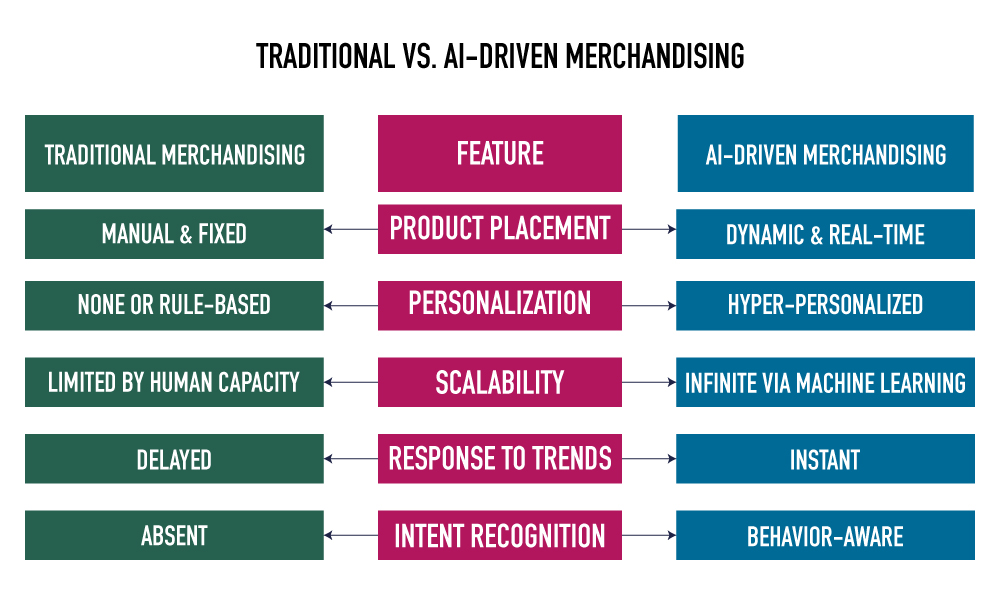
Before the rise of online shopping, physical stores were run on instinct. A manager would decide where to place the sweaters or when to bring out the clearance rack. It worked, to an extent.
But as shopping moved online and the number of products grew, this old model started to fail. Early ecommerce systems were rule-based. If an item was popular, it was shown to more people. If it was spring, the homepage turned green. These rules were simple. But the internet was not.
One viral video could make a niche item sell out in hours. A sudden wave of bad reviews could tank a top seller in a single night. The rules couldn’t keep up, and they couldn’t adapt.
For those offering ecommerce integration services, this became a problem. But it also became an opportunity. Because AI does not need fixed rules. It learns from the data. And it rewrites the rules every day.
The Key Benefits of AI-Driven Merchandising
In 1999, a small bookstore in Manhattan did something unusual. They rearranged their books based on customer feedback, not bestseller charts. Sales went up. Visitors stayed longer. Customers felt like the store got them.
AI-driven merchandising takes that simple idea and scales it to millions of people.

Hyper-Personalization at Scale
Visit a leading online store today, and the homepage is personalized. It may know your favorite colors. Your shopping history. The time of day you tend to browse. Every visit shapes what happens next.
For anyone building ecommerce implementation services, this is now a must-have. These platforms nudge shoppers toward forgotten items, remind them of products they considered, and offer just the right thing at just the right moment.
Dynamic Sorting and Ranking
Before AI and real-time data, product rankings followed fixed plans. Today, AI can change the order of products every minute if needed, based on what’s trending, where you live, or what similar users are buying.
This is a game-changer for ecommerce integration services. It lets stores keep up with customers instead of chasing them.
Enhanced Site Search and Discovery
Search bars used to be unforgiving. Misspell a word and you’d see zero results. Now, thanks to AI-powered engines like Algolia, search understands questions, typos, and even half-formed ideas.
It’s less like shouting a keyword and more like having a conversation. That’s a big shift in how customers interact with your store.
Inventory and Margin-Aware Recommendations
AI doesn’t just think about the customer. It can balance that with what’s in stock, what has better profit margins, and what needs to move before the season ends.
For online merchants and ecommerce development agencies, this makes every suggestion smarter and more strategic.
Continuous Learning and Optimization
Traditional systems follow instructions. AI learns from behavior. The more it sees, the smarter it gets. It adapts to new habits, new trends, and even changing user moods.
For long-term success, this isn’t just helpful; it’s vital, because it means your store is always growing, always improving, on its own.
Who Benefits from AI-Driven Merchandising?
AI-based merchandising isn’t just smart. It’s strategic. It supports real roles in different industries, solving specific challenges through continuous learning and optimization. Here’s how AI helps across industries and roles:
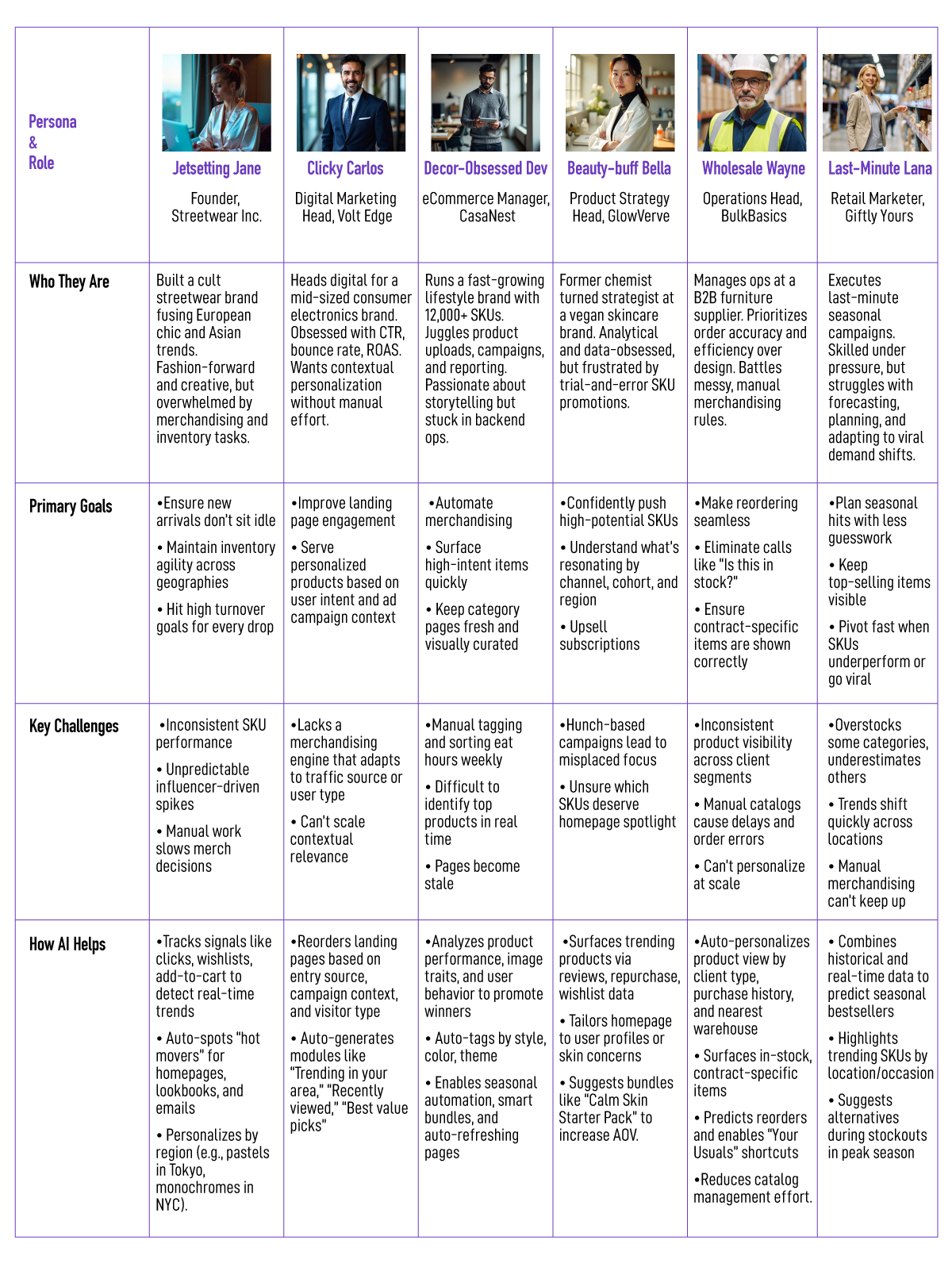
The Real-World Impact
B2C Fashion: Clarks
Clarks, a brand associated with timeless fashion, used to update its online storefront manually. When winter came, boots needed to be promoted. When summer arrived, sandals moved up the list. That was the old rhythm. Then, Clarks adopted Algolia’s AI-powered search and merchandising. Suddenly, trends could be spotted faster. The site began to highlight seasonally relevant products before customers even searched for them. Shoppers were no longer browsing. They were discovering.

In the B2B world, relevance means precision. A customer looking for nut-free frosting shouldn't see a list of brownie mixes, donut glazes, and other unrelated products. Dawn Foods understood this. With Algolia, their catalog stopped behaving like a static list and started acting like a recommendation engine. The AI learned from user behavior. It showed contextually relevant SKUs. A returning user saw reorder suggestions. A first-time visitor got a curated tour. The catalog thus became intuitive.

Mobile-First Shopping: JD Sports
Mobile shopping is not just desktop shopping on a smaller screen. It’s a completely different mindset. JD Sports saw this. Their customers were on the go, often looking for quick inspiration. Algolia helped make the experience smarter. Personalized product tiles are adjusted to individual users. Filters remembered preferences. JD Sports didn’t just shrink their site for mobile - they reimagined merchandising for the mobile mindset, surfacing relevant products in fewer steps and with greater contextual precision.
These aren’t just success stories. They’re signals. AI merchandising isn’t about replacing people. It’s about scaling personalization to every visitor in real time.

The Role of Search in AI-Driven Merchandising
There was a time when search and merchandising lived in different metaphorical rooms. One helped users find what they wanted. The other helped brands show what they needed to sell. Now, those rooms have merged.
Search today isn’t a tool. It’s a strategy. When a shopper types “running shoes,” the goal isn’t just to return matching products. It’s to predict why they’re searching. Do they run on trails or on treadmills? Are they looking for budget-friendly or high-performance? Fast, intelligent search responds in context.
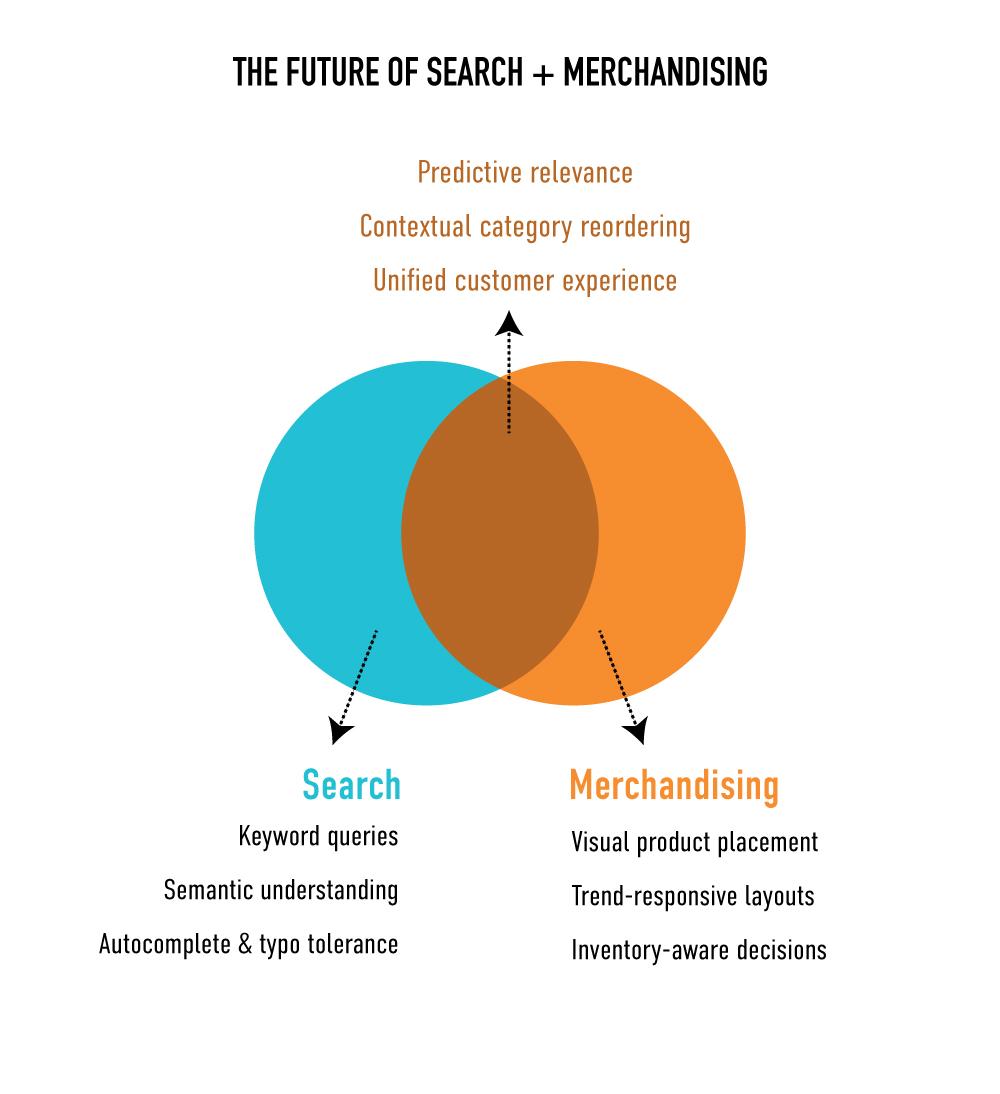
Modern search solutions focus on intent and outcomes. They match what users want with what businesses need. Speed, relevance, and personalization work together to deliver the right result at the right time. The result is not just better conversion rates. It’s a better experience.
Getting Started: How Brands Can Adopt AI Merchandising
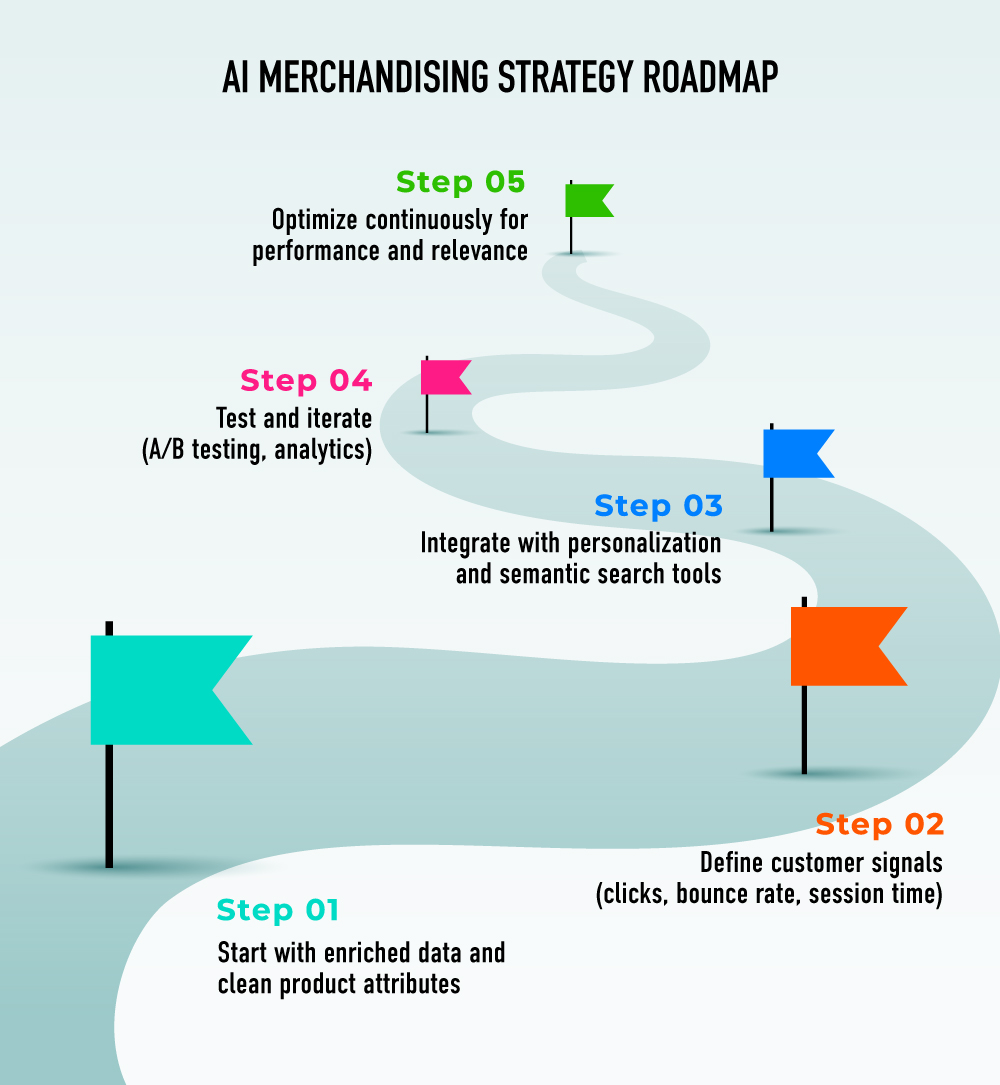
Success in AI merchandising doesn’t begin with algorithms. It starts with data. Not just more data, but better data. Product descriptions need to be complete. Attributes must be structured. User signals like clicks, scrolls, and filters used have to be tracked and fed back into the system.
Once the data foundation is solid, brands need the right tools, which become truly powerful when implemented by experienced ecommerce implementation service partners.
Adoption should be agile. Start small. Test layouts. Run A/B experiments. See how changes to the product grid affect click-through rates. Track KPIs like bounce rate, time on site, and conversion rate. Adjust continuously. AI isn’t static, and your strategy shouldn’t be either.
Why Now? The Urgency of Adopting AI Merchandising
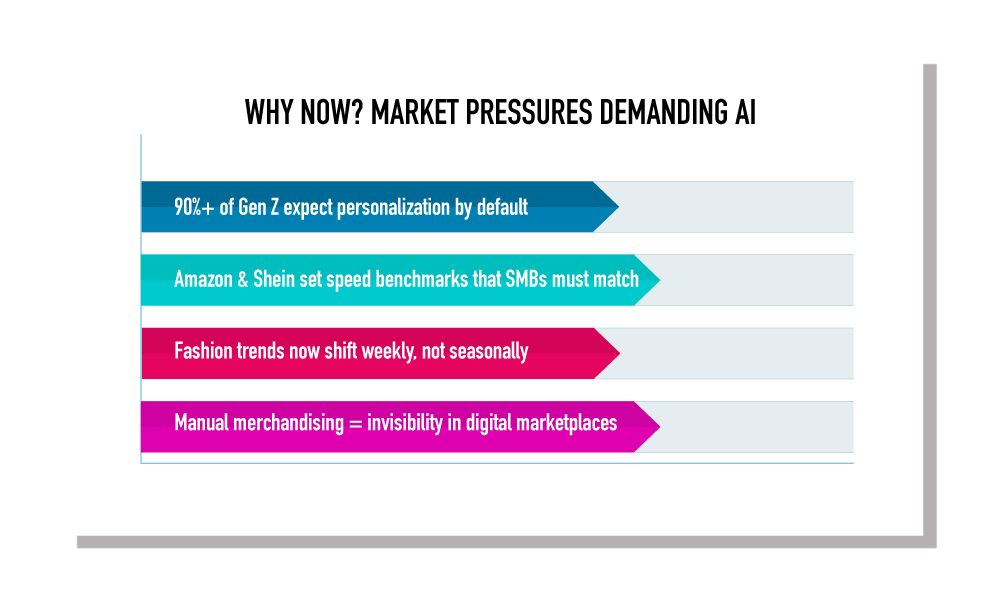
Retailers, even online retailers, used to have time. Trends unfolded slowly. Websites were updated monthly, sometimes even quarterly. That luxury is gone.
Gen Z shoppers swipe and scroll with purpose. They don’t “just” browse. They expect the site to anticipate their needs. If it doesn’t, they bounce — fast.
Marketplaces like Amazon have raised the bar. Their merchandising systems learn in real time. Smaller brands are no longer competing on product alone. They’re competing on experience. The website experience must be seamless.
Traditional merchandising teams are struggling to keep up. Spreadsheets and manual updates can’t match the speed of today’s market. AI doesn’t just help. It’s becoming necessary.
Challenges in Adopting AI-Driven Merchandising
AI in merchandising promises a lot. But getting there isn’t always easy. Four challenges stand out.
-
Data privacy
-
AI needs data to work well. But using personal data comes with responsibility. Regulations like GDPR and CCPA require strict control over what data is collected and how it’s used.
-
Implementation
-
Many systems are not built for real-time AI updates. Teams often need new tools, new workflows, and support from IT to make AI integration work across channels.
-
Ethics
-
AI can reflect bias in the data it learns from. If not managed carefully, it may reinforce stereotypes or push products too aggressively. Responsible design and regular checks are key.
-
Team readiness
-
AI changes how decisions are made. It’s not just a tech shift, it’s an organizational one. Teams must learn to trust AI and use its insights instead of relying only on experience.
Each challenge is real. But with the right approach, each one can be managed.
The Takeaway
Over the next few years, AI-driven merchandising will completely reshape online retail. Generative AI will dynamically create personalized descriptions, visuals and offers for each shopper, transforming static pages into adaptive, customer-centric experiences.
Conversational commerce will mature fast. Chatbots and voice agents will guide users intuitively through discovery and purchasing, interpreting context and intent like a real advisor. Immersive environments will take shape too, from AI-powered virtual stores to AR-style guides on mobile devices and behind the scenes, AI will keep operations sharp by forecasting demand, managing inventory and coordinating logistics with precision.
To thrive, brands must embrace systems that create, converse and coordinate in real time. They need flexible, AI-ready architectures that allow generative content and real-time personalization to work at scale. That means treating chat and voice as core channels, not extras, and testing virtual commerce now.
Companies like Ziffity build the infrastructure, while Algolia delivers the smart search and discovery layer that drives engagement. It’s no longer about having the best products. It’s about being the brand that dreams, talks and delivers in the moment, powered by AI at every turn.
AI Search
The results users need to seeAI Browse
Category and collection pages built by AIAI Recommendations
Suggestions anywhere in the user journeyAdvanced Personalization
Tailored experiences drive profitabilityMerchandising Studio
Data-enhanced customer experiences, without codeAnalytics
All your insights in one dashboardUI Components
Pre-built components for custom journeys




